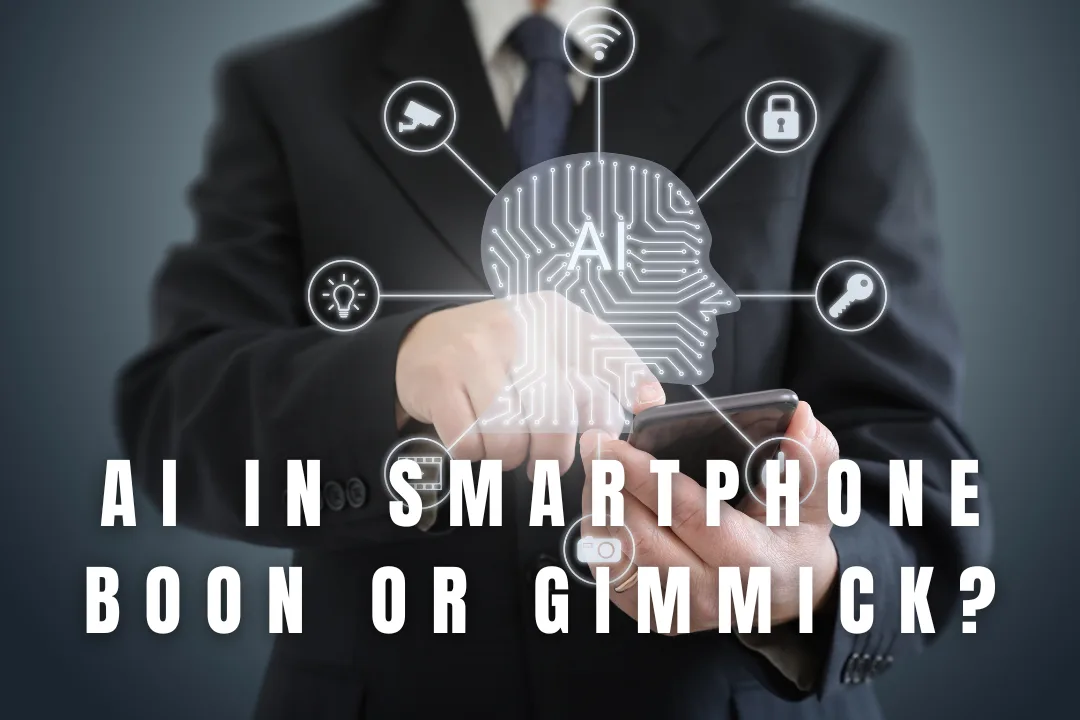Introduction
The technology term Artificial Intelligence (AI) receives widespread popularity within the tech industry while smartphones serve as its major public demonstration platforms. The technologies that empower everything seem to stem from AI enhancements including cameras and voice assistance. The primary question arises regarding the usefulness of smartphone features since they appear more revolutionary than what they actually deliver.
Hello readers! This is Sourav; In this article we are going to discuss about AI in Smartphone, Boon or Gimmick. I encourage you to read the full article for a deeper understanding. Also, feel free to leave a comment below and let me know your thoughts about AI in Smartphone.
The current state of AI in smartphone functions features an explanation of its operational process together with an assessment on its revolutionary capabilities versus marketing trickery.
What Counts as AI in Smartphone?
The use of artificial intelligence within smartphones includes three fundamental components which are machine learning (ML), computer vision and natural language processing (NLP). The programming accomplishes tasks that need human-level intelligence such as face detection and speech comprehension and behavioral prediction.
AI technology exists in distinct regions of smartphones where it enables specific functionalities.
- Photography: Scene recognition, portrait mode, night mode.
- Voice Assistants: Siri, Google Assistant, Bixby.
- Battery Optimization: The software learns user behavior patterns for optimizing system energy conservation.
- App Suggestions & Smart Replies: The operating system employs App Suggestions as well as Smart Replies to predict upcoming user actions.
- Security: Face unlock, fingerprint recognition improvements.
- Translation and Text Recognition: Real-time, on-device translation or OCR.
Sounds impressive on paper. But let’s take a closer look.
AI in Cameras – Boon with Boundaries
Artificial intelligence has brought substantial improvements to photographs taken from smartphones. The technology identifies numerous scenes including sunsets or food along with pets before it automatically adjusts recording settings to optimize each photo. The AI technology on certain phones generates automated bokeh effects in their portrait mode applications.
Night mode is another win. The technology combines several pictures and clears out blurriness then adjusts brightness allowing users to capture usable images even in total darkness.
But is it always a win?
Pros:
- Great photos with little effort.
- Helps non-photographers take better shots.
- Night mode enables users to operate their devices longer when light conditions are dim.
Cons:
- Over-processing: Colors can look unnatural.
- Removes creative control.
- The system sometimes produces variable or improper results through its filter mechanisms that affect facial representations.
This enhancement feature brings many benefits yet slightly crosses the boundary between technical help and image manipulation. Useful for the average user, but not a substitute for actual photography skills.
Voice Assistants – Gimmick More Often Than Not
People expected voice assistants to bring groundbreaking changes to the world. Speech commands were supposed to function as the basis for phone commands so users could tell their devices what actions to perform. Reality is… messier.
The current version of Google Assistant along with similar voice assistants shows progress but remains constrained in their functions. Users can establish alarms with their voice as well as receive answers to simple queries because the system lets them manage smart applications and deliver messages. But nuance? Context? Follow-ups? Still a work in progress.
Pros:
- Hands-free use.
- Great for accessibility.
- Works well for basic tasks.
Cons:
- The system lacks sufficient capability to handle complicated requests within specific contexts.
- Privacy concerns with always-on microphones.
- Rarely used beyond basic features.
According to research from 2023 most people only use voice assistants for minor tasks while listening to music or preparing timers. Users can only perform limited tasks through this widely advertised capabilities.
Verdict: Mostly a gimmick. Voice AI technology fails to deliver its expected promise because most users either do not utilize smart house features or need specific accessibility accommodations.
AI for Battery Life – Quiet but Smart
The battery optimization system powered by AI operates under the surface without drawing attention. The system tracks app usage patterns to modify performance and charging patterns and background behavior thus enhancing battery longevity.
The battery optimization systems of Google and Apple set excellent standards as shown by their Adaptive Battery and Optimized Battery Charging solutions. The algorithms use artificial intelligence to reduce battery exhaustion while effectively managing power consumption.
Pros:
- Subtle but useful.
- The system helps batteries maintain longer operational duration in the future.
- Users do not need to provide any input for the execution of this system.
Cons:
- The changes occur only through continuous monitoring.
- The performance outcomes depend on how the user utilizes their devices.
Verdict: Definite boon. Not sexy, but effective. AI operates so well in this case that it does its job discreetly.
Smart Suggestions – Hit or Miss
Phones in the present day make attempts to forecast what users need next. Typing a message? You’ll get smart replies. Opening the app drawer? You’ll see predicted apps. Charging your phone? The operating system of phones proceeds by recommending users to activate Bedtime Mode.
The technology relies on Artificial Intelligence algorithms which deliver these gentle prompts. Automobile Fill and Smart Email Compose come under the best categorization of smartphone functionality. Random suggestions and annoying features characterize the interactions with some smartphone functionalities.
Pros:
- Can speed up frequent tasks.
- Feels intuitive when it works.
Cons:
- Can feel invasive or creepy.
- Inconsistent usefulness.
- You can only use the system functions in such a limited fashion that they remain meaningless for daily tasks.
Verdict: Mixed. Productivity increases through correct implementation of this system. The majority of digital overloads serve no purpose other than filling screen space.
AI in Security – Real Value
These mobile features have existed in the market for multiple years along with fingerprint detection. AI technology enhanced two system capabilities above normal standards. Modern smartphones use intelligent technology which enables them to adapt to face appearance changes like glasses or facial hair and to identify lesser portions of your fingerprint.
The iPhone’s Face ID technology represents advanced facial mapping which depends on substantial AI capability to function securely and accurately.
Pros:
- Faster, more reliable unlocking.
- Harder to spoof.
- The addition delivers both convenience and safety benefits to users.
Cons:
- Facial data privacy concerns.
- Mail-invoice processing tends to fail during specific unusual situations such as when individuals wear masks.
Verdict: Strong boon. AI implements genuine improvements to biometric security through enhanced performance and precision with reduced incorrect identifications.
AI Translation and Text Recognition – Quiet Revolution
Thankfully iPhone and Android devices provide users with Google Lens alongside Apple’s Live Text which enables immediate translation and automated document or text capture functions. A combination of strong artificial intelligence resides on these devices which operates independently of cloud-dependent data transfer.
Pros:
- Works offline.
- The capability is beneficial for everyday operations including travel along with document handling and studying.
- Fast and increasingly accurate.
Cons:
- The available features remain difficult to access.
- Handwriting detection or dim light conditions make the system difficult to use.
Verdict: Big boon. Especially useful for students, travelers, and professionals. The use of these AI tools demonstrates obvious practical applications.
Marketing vs. Reality – The Gimmick Trap
The majority of products labeled as “AI” features primarily consist of automated systems or pattern recognition algorithms. The use of “AI” as a branding label occurs across many products since customers view it as representing advanced technology.
Examples:
- The “AI Beautification” features function by softening skin texture while making eye openings larger.
- The “AI Voice Isolation” function provides the same level of noise reduction as simple voice reduction systems.
- The application “AI Gaming” contains only one capability since it automatically clears applications that run in the background.
The widespread misuse of artificial intelligence terminology makes the term lose its value while causing users to become fatigued. AI becomes meaningless whenever it appears before everything because it fails to establish any unique difference.
So, Boon or Gimmick?
Let’s sum it up by category:
| Feature | Verdict |
|---|---|
| Camera Enhancements | Mostly Boon |
| Voice Assistants | Mostly Gimmick |
| Battery Optimization | Clear Boon |
| Smart Suggestions & Predictive UI | Mixed Bag |
| Security (Face/Fingerprint) | Solid Boon |
| Text Recognition & Translation | Strong Boon |
| Marketing Buzzwords | Often Gimmick |
Final Thoughts: Is AI Worth It in Phones?
The presence of Artificial Intelligence within smartphones functions as multiple features which range from genuine advancements to artificial marketing initiatives. These perfect implementations operate without disturbance while enhancing your experience automatically. The worst feel like features for features’ sake.
True innovation persists in artificial intelligence during a period of decreasing smartphone developments among annual update cycles. But consumers should stay skeptical. Any technological capability which sounds unreal beyond reason will most likely be imaginary.
The placement of AI technology within smartphones remains in doubt as a benefit or unnecessary extra feature.
It’s both.
The distinct element comes from different implementation methods alongside the question of solving authentic customer needs or creating extra marketing specs.
So, this is all for now, we’d love to hear from you. Feel free to share your suggestions or questions in the comments below about AI in Smartphone and don’t forget to share them with friends and others who might benefit! Save Consumerviews.in your bookmark for easy access, and follow our Facebook Page Consumerviews India for more articles like this.















0 Comments